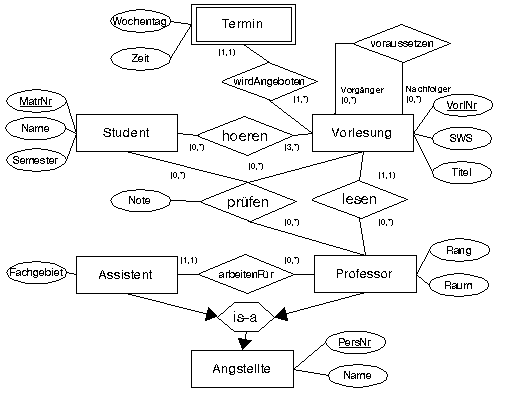Tutorial
Here it a example of using the system. A school-book-databases was chosen, so that all qualities of the system can be shown. The step consequence corresponds possibly to the production by real DB-applications. First a ER-diagram of the system is constructed and is illustrated in relational schema. Then this schema is converted with the help of reverse engineering colleges of technology into a XML-Repository.
Relational schema
Accepted a databases-schema with the help of ER-model design. This schema gets 5 Entities. Besides, is specialized office workers to assistant and professor. With appointment it is about a Weak-Entity. It is here the modeling the Aggregation (better composition) from sets-attribute of the object. There is also different take from relations. Examine a connection(affair) the degree 3 with own attribute is a mark(note).

Angestellte {PersNr,Name}
Professor {PersNr,Rang,Raum}
Assistent {PersNr,Rang,Raum,Professor}
Student {MatrNr,Name,Semester}
Vorlesung {VorlesungNr,Titel,SWS,PersNr}
hoeren {MatrNr,VorlesungNr}
voraussetzten {VorgaengerNr,NachfolgerNr}
pruefen {MatrNr},VorlesungNr,PersNr,Note}
Termin {VorlesungNr,Wochentag,Zeit} |
 | The MySql databases have to be installed on your system. It runs and you have to put on corresponding rights the databases and tables. |
[User@localhost] mysql mysql >CREATE DATABASE university |
>cat sample/unibank.sql | mysql-u username university |